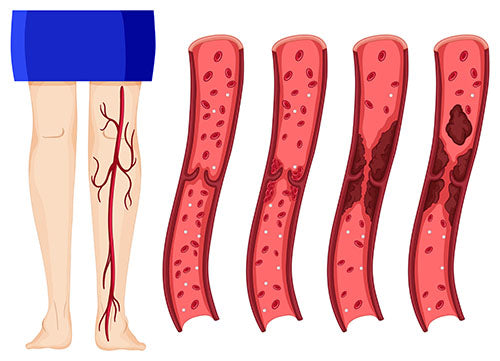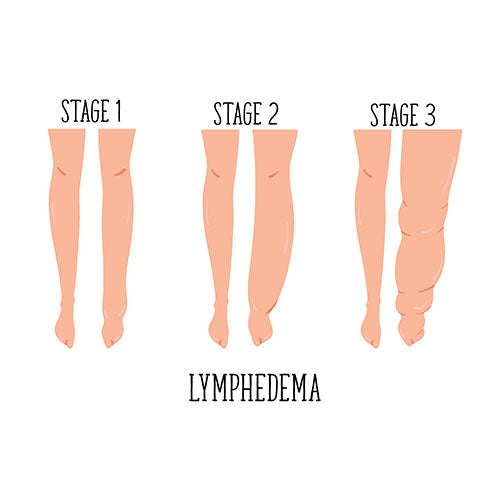Understanding Compression Sock Levels: Extra-Firm Compression Socks
We continue our series of compression level guides with a closer look at extra-firm compression socks. Discover what conditions extra-firm compression can help manage and who should talk to their doctor about wearing extra-firm compression. Then take a deep dive into three conditions that extra-firm compression is often used in the treatment of deep vein thrombosis (DVT), severe lymphedema and chronic venous insufficiency (CVI).

What is extra-firm compression?
Extra-firm compression socks fall into the range of 30-40 mmHg. (mmHg—a.k.a. millimeters of mercury—is a unit of pressure used for compression soc
ks, blood pressure levels and other medical scenarios).
Extra-firm compression can help manage conditions such as:
- Deep Vein Thrombosis (DVT)
- Chronic Venous Insufficiency (CVI)
- Moderate to severe lymphedema
- Moderate to severe swelling
- Post-traumatic swelling
- Orthostatic hypotension
-
Pre-/post-surgery
- Sclerotherapy
- Phlebectomy
- Vein stripping
- Orthopedics
- Post Thrombotic Syndrome (PTS)
- Active venous ulcers, as well as post-treatment
Who should use extra-firm compression socks?
Individuals experiencing a variety of venous conditions can benefit from extra-firm compression socks. Deep Vein Thrombosis (DVT), Chronic Venous Insufficiency (CVI) and moderate to severe lymphedema are three of the most common reasons that people turn to extra-firm compression; more on each of these three conditions below.
Extra-firm compression may also be used to promote good circulation and healing before and after a variety of venous procedures, such as sclerotherapy. You should talk with your doctor before donning any extra-firm compression garments; this higher level of compression should only be worn if a doctor has specifically told you to do so.

What is Deep Vein Thrombosis (DVT)?
Deep Vein Thrombosis (DVT) occurs when a blood clot forms in the deep veins of the body. Common symptoms of DVT include skin redness, pain or swelling in the affected body part and warmth and tenderness around the vein. These deep vein clots may form anywhere but are most common in the legs.
DVT may lead to several other conditions. Thrombophlebitis is when a blood clot forms in one of your veins and slows the blood flow, causing inflammation that can cause swelling. If the clot breaks up and travels to the lungs, it can block an artery and result in a pulmonary embolism. PEs can potentially be fatal and cause many other serious symptoms.
Compression can help with DVT prevention by encouraging your blood to keep flowing. This reduces the chances that your platelets will be able to slow down and clot together.

What is Lymphedema?
Lymphedema is swelling that occurs when the lymph system becomes blocked and backs up. It usually manifests in only one limb or body part at a time. It may occur spontaneously but often manifests after surgery, injury, cancer treatment and other traumatic events. Lymphedema can be mild and hardly noticeable or severe and very painful.
Extra-firm compression can help prevent lymphedema swelling by keeping the skin from expanding to accommodate the pooled lymph. It also encourages the flow of lymph, as well as blood, which reduces the chances that these fluids will pool and swell. However, in other cases, the tight compression may increase your risk of developing lymphedema, so be sure to talk to your doctor before you buy any compression gear.
What is Chronic Venous Insufficiency?
Chronic Venous Insufficiency (CVI) is a condition that occurs when the veins of the legs don’t work properly, which keeps blood from flowing back to the heart as it should. This can cause blood to pool in the legs. While not as serious as DVT or a pulmonary embolism, CVI can be very painful and even disabling. Symptoms of CVI include pain, swelling, cramps, changes in the skin, varicose veins and leg ulcers.
Extra-firm compression can help restore circulation in those living with CVI. The tight compression fabric puts healthy pressure on the blood vessels of the lower body, encouraging the blood to flow back up to the heart. If you put the socks on in the morning, the compression fabric can also help prevent the swelling that often accompanies CVI as you go about your day.
If severe venous conditions impact your quality of life, extra-firm compression stockings may be able to help you manage your symptoms. Talk to your doctor today to discover if extra-firm compression can help your venous issues.
Kaki Zell - Vice President of Sales, Marketing, eCommerce at Legs-4-Life LLC Kaki holds a Bachelor of Science degree in Business Administration and Management from Virginia Polytechnic Institute and State University. She’s been working in the medical device industry for over 11 years and currently serves on the Board of Directors for the Greensboro Science Center.
Written November 2019 | Page last updated April 2022
Sources:
Bellamah Vein Center. “Do Compression Stockings Cure Venous Insufficiency?” https://veinmontana.com/do-compression-stockings-cure-venous-insufficiency/
Johns Hopkins Medicine. “Chronic Venous Insufficiency” https://www.hopkinsmedicine.org/health/conditions-and-diseases/chronic-venous-insufficiency
Healthline. “DVT Compression Stockings: Benefits, Uses, and More” https://www.healthline.com/health/dvt/compression-stockings
Mayo Clinic. “Lymphedema - Symptoms and Causes” https://www.mayoclinic.org/diseases-conditions/lymphedema/symptoms-causes/syc-20374682
MedlinePlus. “Deep Vein Thrombosis” https://medlineplus.gov/deepveinthrombosis.html